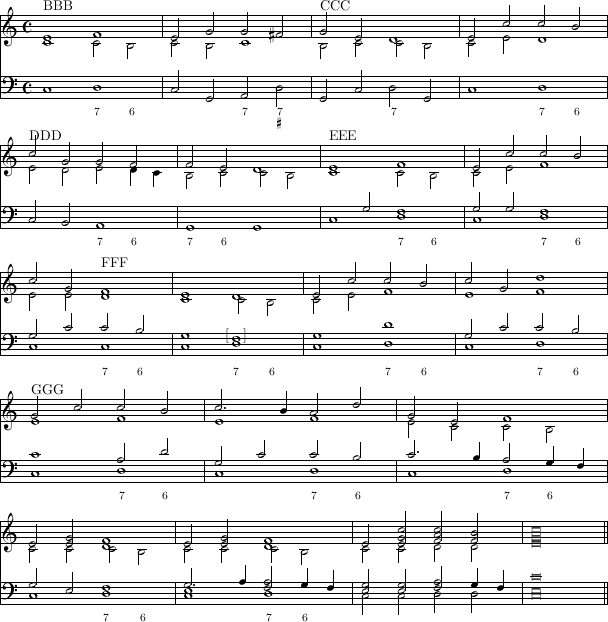|
Von der Septima.
Aus der Septima entstehen vornemblich dreÿerleÿ Concenten, erstlich Septima
sÿncopata, die gebundene Sept.
|
On the Seventh.
From the seventh originate mainly three chords, firstly septima
syncopata, the tied seventh.
|
De la Septième
Trois accords tirent principalement leur origine de la septième,
en premier septima syncopata, la septième liée.
|
|
Andertens Septima pulsata, die geschlagene Sept.
|
Secondly septima pulsata, the struck seventh.
|
Ensuite la septima pulsata, la septième plaquée.
|
|
Drittens Septima transiens, die durchgehende Sept.
|
Thirdly septima transiens, the passing seventh.
|
Troisièmement la septima transiens, la septième passante.
|
|
[p. 28] Septima sÿncopata, die gebundene Sept, wird erkennt, da sich
der Baß zu der Sept bewegt, hingegen die obere Stimm leichtlich in vorigen
Grieff die Sept vorbereiten und binden kann, welche als dann in nachfolgenden
Grieff jederzeit abwerts gradatim aufgelöst werden soll.
|
Septima syncopata, the tied seventh, one recognises by the bass moving
into the seventh, while the upper voice can easily prepare and tie the seventh
in the previous Grieff, which should always be resolved descending
gradually in the subsequent Grieff.
|
On reconnait la septima syncopata, la septième liée, quand la basse
bouge vers la septième et que la voix supérieure peut donc facilement
préparer et lier la septième dans le Grieff précédent, qui doit
toujours être résolue en descendant conjointement dans le Grieff
succédant.
|
Mit 3 Stimm sezt man zu der Sept vornemblich die Terz, BBB, bisweilen auch die
Octav, wann nur der Baß in einer nit gar zu harten Noten oder Diesi  stehet, CCC, entlich auch kann die Quint wohl mit der Sept lauten, DDD.
stehet, CCC, entlich auch kann die Quint wohl mit der Sept lauten, DDD.
|
With three voices one puts mainly the third with the seventh, BBB, sometimes
also the octave, if the bass does not have a too hard note or diesi  ,
CCC, finally also the fifth may sound nice with the seventh, DDD. ,
CCC, finally also the fifth may sound nice with the seventh, DDD.
|
À trois voix, on ajoute surtout la tierce à la septième, BBB, parfois
aussi l'octave quand la basse n'est pas une note trop dure ou dièsée
 , CCC, finalement aussi la quinte sonne bien avec la septième,
DDD. , CCC, finalement aussi la quinte sonne bien avec la septième,
DDD. |
Mit 4 Stimmen und mehrern gebraucht man sich zu der Sept vornemblich der Terz,
so vor andern den Vorzug hat, auch fieglich kann verdoppelt werden, EEE, oder
man sezt zu der Sept und Terz die Octav, wann die Noten des Baß kein Diesis
 hat oder ein harte Noten ist, FFF, oder entlich an stat der Octav wird
neben der Sept und Terzen ein Quint genomen. hat oder ein harte Noten ist, FFF, oder entlich an stat der Octav wird
neben der Sept und Terzen ein Quint genomen.
|
With four voices and more one uses mainly the third with the seventh, which is
to be preferred against the others, and it can well be doubled, EEE, or one
puts the third and the octave with the seventh, if the note in the bass does
not have a diesis  or if is not a hard note, FFF, or finally instead of
the octave one takes a fifth together with the seventh and the third. or if is not a hard note, FFF, or finally instead of
the octave one takes a fifth together with the seventh and the third.
|
À quatre voix ou plus, on ajoute surtout la tierce à la septième, qui
est à préférer par rapport aux autres, et elle peut facilement être doublée,
EEE, ou alors, on joue la tierce et l'octave avec la septième, si la note de
la basse n'est pas un dièse  ou une note dure, FFF, ou
finalement, on joue une quinte avec la septième et
la tierce à la place de l'octave. ou une note dure, FFF, ou
finalement, on joue une quinte avec la septième et
la tierce à la place de l'octave. |
|
Mit 5 und mehr Stimen duplirt man nach Belieben die Terz, die Octav und die
Quint, HHH.
|
With five and more voices one doubles the third at will, the octave and the
fifth, HHH.
|
À cinq voix ou plus, on double la tierce l'octave ou la
quinte à volonté, HHH.
|
|
Doch ist zu beobachten, daß die Sept niemahl dupliert wird.
|
But it is to observe that the seventh is never doubled.
|
Mais on doit prendre garde à ce que la septième ne soit jamais doublée.
|
 stehet, CCC, entlich auch kann die Quint wohl mit der Sept lauten, DDD.
stehet, CCC, entlich auch kann die Quint wohl mit der Sept lauten, DDD.
 ,
CCC, finally also the fifth may sound nice with the seventh, DDD.
,
CCC, finally also the fifth may sound nice with the seventh, DDD.
 , CCC, finalement aussi la quinte sonne bien avec la septième,
DDD.
, CCC, finalement aussi la quinte sonne bien avec la septième,
DDD.  hat oder ein harte Noten ist, FFF, oder entlich an stat der Octav wird
neben der Sept und Terzen ein Quint genomen.
hat oder ein harte Noten ist, FFF, oder entlich an stat der Octav wird
neben der Sept und Terzen ein Quint genomen.
 or if is not a hard note, FFF, or finally instead of
the octave one takes a fifth together with the seventh and the third.
or if is not a hard note, FFF, or finally instead of
the octave one takes a fifth together with the seventh and the third.
 ou une note dure, FFF, ou
finalement, on joue une quinte avec la septième et
la tierce à la place de l'octave.
ou une note dure, FFF, ou
finalement, on joue une quinte avec la septième et
la tierce à la place de l'octave. 

